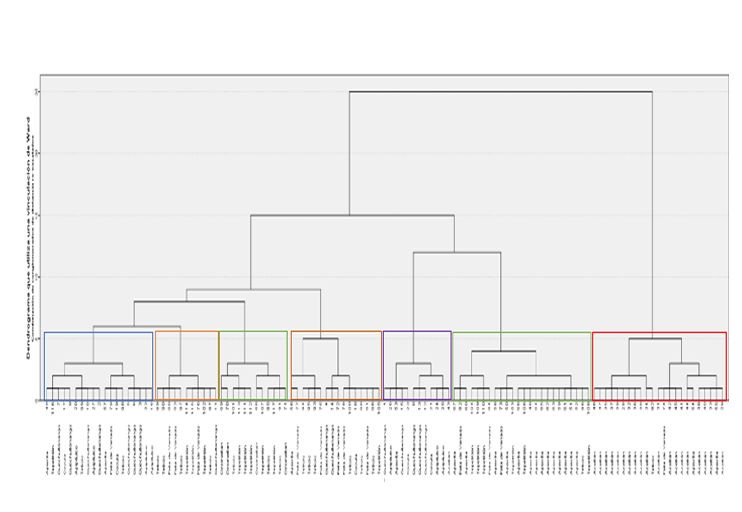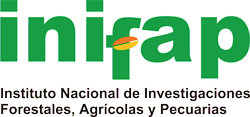Socioeconomic and productive characterization of native bean producers in Guerrero
DOI:
https://doi.org/10.29312/remexca.v16i2.3541Keywords:
commercialization, communities, conservation, productionAbstract
Beans (Phaseolus vulgaris L.) are important in the Mexican diet; they are grown in all regions of Mexico in 1 690 000 ha, with a production of 1 289 000 t and per capita consumption of 11 kg. Guerrero is the sixth largest bean producing state nationwide with 27 014 producers and a production of 11 155 t. The objective was the socioeconomic and productive characterization of native bean producers from nine localities in three regions of Guerrero, Mexico. An interview with questions about social, economic, and production variables was applied to 117 bean producers from nine communities in three regions (North, Central, and Mountain) of Guerrero, Mexico. A cluster analysis was applied to the data collected, using factor analysis for the selection of variables and defining the hierarchical cluster with Ward’s method and the Euclidean distance, resulting in seven groups of producers. Sixty-three point two percent of producers are men, 62.4% have an elementary level of education, 17% speak an indigenous language, the average age was 48 years, and 59.8% use family labor for bean cultivation. Agriculture is their main economic activity, with 22 years of experience in this crop, planted on 0.8 ha with an average yield of 250 kg ha-1. The results contribute to identifying the problems regarding the production process, postharvest management, and sales, as well as the actors that limit bean productivity, putting at risk its long-term conservation in some communities of Guerrero, Mexico.
Downloads
References
Altieri, M. y Nicholls, C. 2013. Agroecología: única esperanza para la soberanía alimentaria y la resiliencia. Socioecológica. 7(2):65-83.
Amaro, C. A. R. 2010. Diagnóstico en materia de salud pública en el estado de Guerrero. Encrucijada Revista electrónica del centro de estudio de administración pública. Universidad Nacional Autónoma de México (UNAM). Quinto número. 1-13 pp.
Ayala, D. A. y García, R. 2009. Contribuciones metodológicas para valorar la multifuncionalidad de la agricultura campesina en la Meseta Purépecha. Economía, Sociedad y Territorio. 31(4):759-801.
Ayala, G. A. V.; Schwentesius, R. R. y Gómez, C. M. A. 2011. Liberalización comercial del sector agropecuario de México: Competitividad del frijol. Revista Globalización, Competitividad y Gobernabilidad. Portal Universia S.A. 5(1):54-84.
Benítez-García, E.; Jaramillo-Villanueva, J. L.; Escobedo-Garrido, S. y Mora-Flores, S. 2015. Caracterización de la producción y del comercio de café en el Municipio de Cuetzalan, Puebla. Agricultura, Sociedad y Desarrollo. 12(2):181-198.
Borja, B. M.; Arellano, A. S.; Sánchez, T. B. I. y García H. R. V. 2021. El cultivo del frijol presente y futuro para México. Sistemas de producción de frijol en temporal en el centro norte de México: diferencias tecnológicas y económicas. Instituto Nacional de Investigaciones Forestales, Agrícolas y Pecuarias (INIFAP). Libro técnico núm. 1. 101-114 pp.
CEDRSSA. 2020. Centro de Estudios para el Desarrollo Rural Sustentable y la Soberanía Alimentaria. Mercado del frijol, situación y prospectiva. Palacio Legislativo de San Lázaro. México. 1-18 pp.
Coronado-Minjarez. M. A.; Figueroa-Rodríguez, K. A.; Figueroa-Sandoval, B.; García-Herrera, E. J. y Ramírez-López, A. 2019. Caracterización y clasificación de los productores del Altiplano Oeste Potosino, México: una propuesta de tipología multidimensional. Agricultura Sociedad y Desarrollo. 16:373-397.
Davis, B. 2004. Instrumentos políticos innovadores y evaluación en el desarrollo agrícola y rural en América Latina y el Caribe. Temas actuales y emergentes para el análisis económico y la investigación de políticas (CUREMIS II). 1-17 pp.
ENA. 2019. Encuesta Nacional Agropecuaria. Instituto Nacional de Estadística y Geografía. https://www.inegi.org.mx/contenidos/programas/ena/2019/doc/rrdpenapdf.
FIRA. 2015. Fideicomisos Instituidos en Relación con la Agricultura. Panorama Agroalimentario. Secretaria de Hacienda y Crédito Público. México, DF.
FAO. 2003. Organización de las Naciones Unidas para la Agricultura y la Alimentación. Manual para la preparación y venta de frutas y hortalizas del campo al mercado. Boletín de servicios agrícolas de la FAO. 151 p.
FAO. 2017. Organización de las Naciones Unidas para la Agricultura y la Alimentación. Estadísticas de la producción mundial. http://www.fao.org/fishery/statistics/í de la producción mundial. http://www.fao.org/fishery/statistics/e.
Gobierno del estado de Guerrero. 2015-2021. Programa regional Centro. Secretaría de Planeación y Desarrollo Regional. http://i.guerrero.gob.mx/uploads/2016/10/CENTRO.pdf.
Guzmán, S. De la, G. C.; García, S.; Rebollar, R. y Hernández, M. 2019. Análisis económico del mercado de frijol grano en México. Agronomía Mesoamericana. 30(1):131-146.
INIFAP. 2015. Instituto Nacional de Investigaciones Forestales, Agrícolas y Pecuarias. Paquete tecnológico para frijol de temporal potencial alto. Secretaría de Agricultura y Desarrollo Rural (SADER).
INIFAP. 2015b. Instituto Nacional de Investigaciones Forestales, Agrícolas y Pecuarias. El cultivo del frijol presente y futuro para México. Secretaria de Agricultura y Desarrollo Rural. Libro técnico Núm. 1. México, DF.
INIFAP. 2021. Instituto Nacional de Investigaciones Forestales, Agrícolas y Pecuarias. Variedades de frijol (Phaseolus vulgaris L.) del INIFAP. Secretaría de Agricultura y Desarrollo Rural. Libro técnico No. 2. México.
INEGI. 2019. Instituto Nacional de Estadística y Geografía. Encuesta nacional agrícola. https://www.inegi.org.mx/contenidos/saladeprensa/boletines/2020/ENA/Ena.pdf.
INEGI. 2020. Instituto Nacional de Estadística y Geografía. Comunicado de prensa núm. 251/22.https://www.inegi.org.mx/contenidos/saladeprensa/aproposito/2022/EAPMamas22.pdf.
Jaramillo, A. J. G.; Valeriano, P. O. B.; Hernández, S. J. H.; Díaz, R. R. y Espinosa, C. A. 2018. Caracterización de productores de maíz de temporal en Tierra Blanca, Veracruz. Revista Mexicana de Ciencias Agrícolas. 9(5):911-923.
Martínez, A. F. B.; Guevara, H. F.; La O, A. M. A.; Rodríguez, L. L. A.; Pinto, R. R. y Aguilar, J. C. E. 2020. Caracterización de productores de maíz e indicadores de sustentabilidad en Chiapas. Revista Mexicana de Ciencias Agrícolas. 11(5):1031-1042.
Ordaz, D. J. L. 2009. México: impacto de la educación en la pobreza rural. CEPAL-Serie Estudios y Perspectivas Núm. 105. México. 3-40 pp.
Osuna, C. E. S.; Reyes, M. L.; Martínez, G. M. A.; Acosta, G. J. A. y Arellano, A. S. 2013. Fertilización foliar, un complemento de bajo costo para aumentar el rendimiento de frijol. Instituto Nacional de Investigaciones Forestales, Agrícolas y Pecuarias (INIFAP)-Campo Experimental Pabellón Aguascalientes, México. Desplegable para productores núm. 45.
Pérez, T. H. y Galindo, G. G. 2003. Situación socioeconómica de los productores de frijol de temporal en Zacatecas. Terra Latinoamericana. 21(1):137-147.
Rojas, R. T. J. 2017. Migración rural jornalera en México: la circularidad de la pobreza. Revista de Ciencias Sociales de la Universidad Iberoamericana. 7(23):1-35.
Salazar, L.; Schling, M.; Palacios, A. C. y Pazos, N. 2021. Retos para la agricultura familiar en el contexto del COVID-19: Seguimiento tras seis meses de crisis. Banco Interamericano de Desarrollo. 1-22 pp.
Santillán, J.; Oble, E. y Chauvet, M. 2019. Efectos de las políticas públicas en la conformación de organizaciones de productores de frijol en Zacatecas. Secretaría de Agricultura, Ganadería, Desarrollo Rural, Pesca y Alimentación (SAGARPA). Planeación Agrícola Nacional 2017-2030. Frijol Mexicano.
SIAP. 2017. Servicio de Información Agroalimentaria y Pesquera. Producción Agrícola. https://www.gob.mx/siap/acciones-yprogramas/produccion-agricola-33119.
SIAP. 2019. Servicio de Información Agroalimentaria y Pesquera. Boletín mensual. Balanza disponibilidad-consumo. Secretaría de Agricultura y Desarrollo Rural (SADER). México, DF.
SIAP. 2022. Servicio de Información Agroalimentaria y Pesquera. Panorama agroalimentario. Secretaría de Agricultura y Desarrollo Rural (SADER). México, DF.
USDA. 2000. United States Department of Agriculture. Base de datos sobre composición de alimentos. http://www.nal.usda/fnic.
Uzcanga, P. N. G.; Cano, G. A. J.; Medina, M. J. y Espinoza, A. J. J. 2015. Caracterización de los productores de maíz de temporal en el estado de Campeche, México. Revista Mexicana de Agronegocios. 36:1295-1305.

Published
How to Cite
Issue
Section
License
Copyright (c) 2025 Revista Mexicana de Ciencias Agrícolas

This work is licensed under a Creative Commons Attribution-NonCommercial 4.0 International License.
The authors who publish in Revista Mexicana de Ciencias Agrícolas accept the following conditions:
In accordance with copyright laws, Revista Mexicana de Ciencias Agrícolas recognizes and respects the authors’ moral right and ownership of property rights which will be transferred to the journal for dissemination in open access. Invariably, all the authors have to sign a letter of transfer of property rights and of originality of the article to Instituto Nacional de Investigaciones Forestales, Agrícolas y Pecuarias (INIFAP) [National Institute of Forestry, Agricultural and Livestock Research]. The author(s) must pay a fee for the reception of articles before proceeding to editorial review.
All the texts published by Revista Mexicana de Ciencias Agrícolas —with no exception— are distributed under a Creative Commons License Attribution-NonCommercial 4.0 International (CC BY-NC 4.0), which allows third parties to use the publication as long as the work’s authorship and its first publication in this journal are mentioned.
The author(s) can enter into independent and additional contractual agreements for the nonexclusive distribution of the version of the article published in Revista Mexicana de Ciencias Agrícolas (for example include it into an institutional repository or publish it in a book) as long as it is clearly and explicitly indicated that the work was published for the first time in Revista Mexicana de Ciencias Agrícolas.
For all the above, the authors shall send the Letter-transfer of Property Rights for the first publication duly filled in and signed by the author(s). This form must be sent as a PDF file to: revista_atm@yahoo.com.mx; cienciasagricola@inifap.gob.mx; remexca2017@gmail.
This work is licensed under a Creative Commons Attribution-Noncommercial 4.0 International license.


